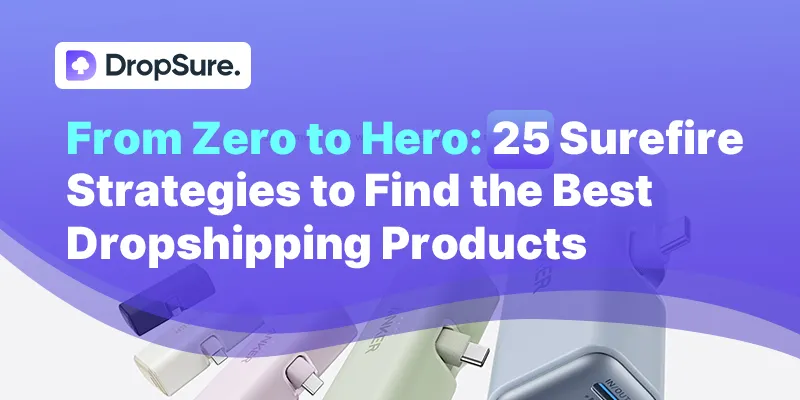Don’t rush into running ads or building your website just yet.
Because… you might end up as one of those 90%+ stores that don’t survive past 3 months. Yes, I’m talking about a failure rate over 90%. It sounds harsh, but that’s the reality.
So why do so many stores shut down within just three months of launching? I’ve summed up 5 truly deadly reasons (and trust me, I’ve fallen into several of these traps myself).
Picking Products Based on Feelings = Cold Sales Instead of Hot Orders
Many beginners in dropshipping pick products purely based on feelings.
What kind of feelings?
“I think this looks cool.”
“It seems to be selling well on TEMU.”
“An influencer just posted this recently; maybe it’ll go viral.”
But here’s the problem — what you like doesn’t mean the market wants it.
What you find appealing might just be a niche favorite with zero real demand.
According to Shopify’s official 2024 report, stores that survive and make money rely heavily on data-driven product selection. It’s not guessing — it’s validating market demand with solid evidence.
Some useful tools for product research:
Google Trends: Check keyword popularity. Don’t list products nobody’s searching for.
SellTheTrend / AliHunter: See what’s really selling well. Don’t work in a vacuum.
TEMU Reviews: Don’t just look at sales volume; focus on negative reviews! Even if a product is hot, if reviews say “poor quality,” “big color differences,” or “slow shipping,” you’re basically stepping on a landmine.
The advice is simple:
Stop only browsing AliExpress best-seller lists.
Use data tools to verify trends and find true winners, while keeping an eye on TikTok trending tags and TEMU review patterns.
Products that sell well but are flooded with bad reviews are high-risk — better not to list them at all.
Don’t Know How to Drive Traffic, Start by Burning Money on Ads
Pitfall 1: Funnel Isn’t Set Up Right — Clicks Wasted for Nothing
● People click on the ad, but the landing page sucks: product images look like they were scraped from a supplier’s website
● Titles are stuffed with keywords — obviously not written for humans
● No trust-building, no purchase reasons, no FAQs
Result: Conversion rate below 0.5%, all your money goes straight to Meta and TikTok.
Pitfall 2: Ad Creatives Look Like PowerPoint Slides — Zero Appeal
● Classic beginner mistake: DIY images and videos that end up looking like 2010 Taobao ads. Copywriting reads like an academic paper
● No visual “pop” in images, no rhythm in videos
● No pain points, no hooks
Pitfall 3: Didn’t Calculate ROI — High GMV but Losing Money
You thought spending $100 on ads would bring $300 in sales?
In reality, many beginners find out too late:
They burned $100 on ads, made $130 in sales, but after deducting product cost, shipping, returns…
They’re losing $10 per order and don’t even feel the pain.
Running ads without calculating ROI is slow financial suicide.
So What Should You Actually Do?
Honestly, if you’re just starting out, don’t rush into paid ads.
Start steady with low-cost product testing:
TikTok short videos: hop on trends, do unboxings, simulate real-life usage
Pinterest: post images + link to your store — slow but super targeted
Reddit communities: find the right Subreddit for your niche, use content or soft reviews to drive traffic
These channels take more time, but they let you test product potential at minimal cost.
Once you’ve found 1–2 seed winners, then it makes sense to scale up with ads.
Don’t Know How to Drive Traffic, Start by Burning Money on Ads
Pitfall #1: Funnel Isn’t Set Up Right — Clicks Wasted for Nothing
People click on the ad, but the landing page sucks: product images look like they were scraped from a supplier’s website
Titles are stuffed with keywords — obviously not written for humans
No trust-building, no purchase reasons, no FAQs
Result: Conversion rate below 0.5%, all your money goes straight to Meta and TikTok.
Pitfall 2: Ad Creatives Look Like PowerPoint Slides — Zero Appeal
Classic beginner mistake: DIY images and videos that end up looking like 2010 Taobao ads. Copywriting reads like an academic paper
No visual “pop” in images, no rhythm in videos
No pain points, no hooks
How are people supposed to stop scrolling, let alone click and buy?
Pitfall 3: Didn’t Calculate ROI — High GMV but Losing Money
You thought spending $100 on ads would bring $300 in sales?
In reality, many beginners find out too late:
They burned $100 on ads, made $130 in sales, but after deducting product cost, shipping, returns…
They’re losing $10 per order and don’t even feel the pain.
Running ads without calculating ROI is slow financial suicide.
So What Should You Actually Do?
Honestly, if you’re just starting out, don’t rush into paid ads.
● Start steady with low-cost product testing:
TikTok short videos: hop on trends, do unboxings, simulate real-life usage
● Reddit communities: find the right Subreddit for your niche, use content or soft reviews to drive traffic
● These channels take more time, but they let you test product potential at minimal cost.
Once you’ve found 1–2 seed winners, then it makes sense to scale up with ads.
Unstable Supply Chain, Bad Reviews That Kill Your Store
To be honest, one of the biggest pitfalls of dropshipping is this:
You have zero control over the product.
● Your supplier runs out of stock and doesn’t tell you — you end up selling thin air
● The product shipped looks nothing like the pictures — customer goes straight to Amazon and files an A-to-Z claim
● Delivery times? A total gamble. Best case: 10 days. Worst case: 40. By then, the customer doesn’t even remember ordering from your store
The Fix:
You must build long-term relationships with reliable suppliers.
AliExpress is fine for getting started, but move on fast to local Chinese dropshipping agents (like GSR, the one you already know).
They’re way more dependable in terms of shipping time and quality control.
No Branding, Just One-Time Sales
The stores that really make money?
They focus on brand building, not just random “throw a bunch of products online and pray” tactics.
If all you do is upload hundreds of products and wait for someone to buy, here’s the reality:
Your repeat purchase rate is almost zero, customer retention costs more, and margins are razor thin.
Data shows:
A store with a 30% repeat purchase rate makes at least 25% more profit than one with just 5%.
So give people a reason to remember you.
Even if you’re selling budget pet supplies, carve out a niche, and nail your visuals and community engagement.
Example:
Launch a “Monthly Pet Challenge” — pick a fun theme each month (like “Funniest Feeding Moment” or “Cutest Pet Dress-Up”), and invite users to post UGC videos tagging your brand’s social media.
Winners get small prizes or discount coupons.
At the same time, nurture old customers by emailing them:
exclusive offers
sneak peeks at new arrivals
behind-the-scenes content
Make them feel like they’re part of a pet lover community, not just a random buyer.
This way, you turn your store into a brand with personality, and over time, your traffic becomes loyal followers.
Result? Higher repeat purchases, stronger word-of-mouth, and fatter profits.

 8 min read
8 min read








